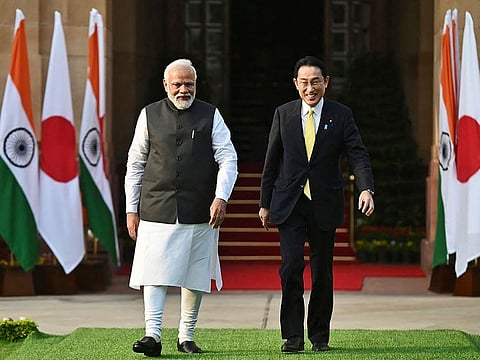Why the future of India-Japan ties is bright
Relationship raised to special, strategic, global partnership during Kishida’s India visit

Japanese Prime Minister Fumio Kishida’s two-day visit to India, which concluded on March 21, may have been low-key, but it was far from being unimportant. Apart from India’s ongoing trade and business partnership with Japan, the visit assumes importance in the light of the current crisis in Ukraine, referred to indirectly as “geopolitical developments” in the official communique.
Prime Minister Kishida was in India for the 14th annual India-Japan summit. The previous summit was in Washington, D.C., between former Japanese Prime Minister Suga Yoshihide and Prime Minister Modi on Sep. 23, 2021.
This is Kishida’s first visit to India as Prime Minister of Japan and the first visit by a Japanese Prime Minister in four and a half years. Kishida, an experienced politician, is no stranger to India. As a long-standing member of the Japanese House of Representatives, having served previously as the foreign minister and acting defence minister of Japan, he is well-acquainted with both Modi and India.
While India is unlikely to change its ostensibly neutral stance, both countries have reiterated their commitment to peace and prosperity. After their meeting at Hyderabad House, New Delhi, Indian Prime Minister Narendra Modi said, “Geopolitical developments are presenting a new set of challenges.
Deepening of India-Japan partnership
In this context, the deepening of India-Japan partnership is not only important for the two countries, but also for the Indo-Pacific region and will encourage peace, prosperity and stability for the world.”
According to the joint statement, both countries “emphasised that the contemporary global order has been built on the UN Charter, international law and respect for sovereignty and territorial integrity of states.” The language, reminiscent to India’s stance at the UN, refrains from naming Russia, but underscores anxieties over the “safety and security of nuclear facilities in Ukraine.”
Just how seriously Japan takes the Russian attack of Ukraine can be gauged from Kishida’s averment, “I have expressed my views to Prime Minister Modi. I conveyed that unilateral attempts to change the status quo by use of force should never be allowed in any sphere.”
We must not forget that Kishida hails from Hiroshima, which along with Nagasaki, was devastated by the world’s first use of atomic weapons. The threat of the Ukraine crisis escalating into a nuclear conflict would thus be intolerable to Japan.
Without question, as members and partners in the Quad, both India and Japan are in favour of peaceful solutions in keeping with international law. Kishida said Japan, along with India, “would keep appealing for a ceasefire, and will want the conflict resolved through diplomacy.”
While most of the 110 minute meeting reportedly focused on Ukraine, Indo-Chinese tensions, Quad, and economic cooperation between Japan and India also featured in the summit. Indo-Nippon friendship, along with other members, United States and Australia, is, of course, key to peace and prosperity in the Indo-Pacific region. Both sides are committed to a “Free and Open Indo-Pacific.”
Special Strategic and Global Partnership
The elevation of Indo-Japanese friendship to a “Special Strategic and Global Partnership” is based not only strategic and diplomatic ties. Both sides agreed to take the relationship forward with a “two-plus-two meeting” between the Foreign and Defence ministers of both countries.
The India-Japan relationship has the strong and solid backbone of economic partnership too. The bilateral trade between the two has crossed $12 billion. India exported close to $4 billion worth of goods and services to Japan, while its imports from that country are close to $8 billion.
What is more, Japanese investment in India is set to exceed 5 trillion yen or $40 billion over the next five years. Japan has also agreed to loan India over Rs20,000 crores for various undertakings to enhance connectivity, water supply, sewerage, horticulture, health care, biodiversity, conservation, clean energy, and cyber security.
Japanese involvement in Indian companies and infrastructure development will also see a big increase over the next five years. Japan has already partnered India in the crucial Mumbai-Ahmedabad High Speed Rail, the Dedicated Freight Corridor, and several metro projects including DMIC.
On the even of his visit, Kishida wrote, “Today, I am visiting India, making my first bilateral visit since my appointment as Prime Minister. Linked by universal values such as freedom, democracy, human rights, and the rule of law, which have been shared through a long history of exchange, Japan and India are “ 'Special Strategic and Global Partners,’ ”which share strategic interests.”
We can be sure that the visit was a success and that both sides were satisfied with the outcomes. The future of Indo-Nippon ties is very bright. With shared values, heightened trust, and convergence of interests, both countries are likely to come closer to each other. What is more, India has much to learn from Japanese values and capabilities.
Order, discipline, hard work, national unity, patriotism, honour, integrity, beauty, neatness, cleanliness, respect for one another, flawless etiquette — some of the virtues amply evident in daily life in Japan can serve India well both today and tomorrow.
What Japan learnt from India in days of yore is, of course, well-known. A visit to Kyoto, or for that matter, any Japanese shrine, will reveal the deep influence of Indian culture and civilisation through the vehicle of Buddhism in the land of the rising sun. It is time to consolidate this shared heritage and to cooperate for a better and more prosperous tomorrow.
Sign up for the Daily Briefing
Get the latest news and updates straight to your inbox



